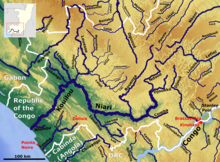You can help expand this article with text translated from the corresponding article in French. (September 2012) Click [show] for important translation instructions.
|
This article needs additional citations for verification. (February 2013) |

The Kouilou-Niari River—also spelled Kwilu, Kwila, or Kwil—is the most important river flowing to the Atlantic Ocean of the Republic of the Congo coast. Moreover, its entire drainage area is completely in the Republic of the Congo. The river is called the Kouilou River while flowing in the coastal region of the Kouilou till the Sounda gorges. Upstream from the gorges, its name is the Niari River and it flows through the Niari Valley. The river combines with the Louessé, the Loudima and the Bouenza River and eventually flows into the Atlantic Ocean. It covers about 560 km from its origin in the Batéké Plateau of the Congo to its mouth at the coast.
The river has numerous waterfalls and is impassable from its mouth, which is of difficult access by multiple sandbars, formed primarily by the action of the Benguela current. The river is usable and boats are coming up to Kakamoéka. From Kakamoéka to Sounda, rapids and rocks are blocking access especially during dry season. Very limited traffic upstream Sounda as they are rapids and a few bridges.
Bridges on the river are located at Bas-Kouilou, Sounda, Kimbangou, Makabana, Loudima and Bouenza.
The Kouilou part is fairly flat with the water level rising only 16 metres above sea level on first 70 km. In the area of Kimbangou, the water level is around 60 metres above sea level and reaches 115 metres at the Loudima junction.